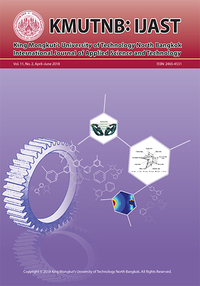Structural Investigation of Poly(lactic acid) Cast Film by Using Synchrotron X-ray Scattering Technique
Main Article Content
Abstract
Microstructure of polymer relates obviously to the materials’ properties. Understanding the orientation and arrangement of the structure guides how to obtain the desirable properties of the final product. This work investigated the preliminary structure of poly(lactic acid) (PLA) cast film by using synchrotron X-ray scattering technique. The PLA was compounded with an epoxidized soybean oil (ESO) and a microcrystalline cellulose (MCC) as a plasticizer and a nucleating agent, respectively. The film products were prepared by using a chillroll cast film extruder. Orientation and crystal structure of the PLA cast films without and with additives were characterized by two-dimensional small angle X-ray scattering (2D-SAXS) and wide angle X-ray diffraction (2D-WAXD) techniques. Moreover, investigation on post-processing, i.e. stretching at room temperature, was carried out by using a homemade stretcher. Varieties of chain arrangement due to the additives and stretching were exhibited.
Article Details
References
[2] E. Castro-Aguirre, F. Iñiguez-Franco, H. Samsudin, X. Fang, and R. Auras, “Poly(lactic acid)-mass production, processing, industrial applications, and end of life,” Advanced Drug Delivery Reviews, vol. 107, pp. 333–366, 2016.
[3] L.-T. Lim, R. Auras, and M. Rubino, “Processing technologies of poly(lactic acid),” Progress in Polymer Science, vol. 33, pp. 820–852, 2008.
[4] C. Bueno-Ferrer, M. C. Garrigós, and A. Jiménez, “Characterization and thermal stability of poly(vinyl chloride) plasticized with epoxidized soybean oil for food packaging,” Polymer Degradation and Stability, vol. 95, pp. 2207–2212, 2010.
[5] N. Prempeh, J. Li, D. Liu, K. Das, S. Maiti, and Y. Zhang, “Plasticizing effects of epoxidized sunflower oil on biodegradable polylactide films: A comparative study,” Polymer Science Series A, vol. 56, no. 6, pp. 856–863, 2014.
[6] F. Ali, Y.-W. Chang, S. C. Kang, and J. Y. Yoon, “Thermal, mechanical and rheological properties of poly(lactic acid)/epoxidized soybean oil blends,” Polymer Bulletin, vol. 62, pp. 91–98, 2009.
[7] Y.-Q. Xu and J.-P. Qu, “Mechanical and rheological properties of epoxidized soybean oil plasticized poly(lactic acid),” Journal of Applied Polymer Science, vol. 112, pp. 3185–3191, 2009.
[8] Y. Song, K. Tashiro, D. Xu, J. Liu, and Y. Bin, “Crystallization behavior of poly(lactic acid)/ microfibrillated cellulose composite,” Polymer, vol. 54, no. 13, pp. 3417–3425, 2013.
[9] L. Suryanegara, A. N. Nakagaito, and H. Yano, “Thermo-mechanical properties of microfibrillated cellulose-reinforced partially crystallized PLA composites,” Cellulose, vol. 17, pp. 771–778, 2010.
[10] A. P. Mathew, K. Oksman, and M. Sain, “Mechanical properties of biodegradable composites from poly lactic acid (PLA) and microcrystalline cellulose (MCC),” Journal of Applied Polymer Science, vol. 97, pp. 2014–2025, 2005.
[11] X. Dai, Z. Xiong, H. Na, and J. Zhu, “How does epoxidized soybean oil improve the toughness of microcrystalline cellulose filled polylactide acid composites?,” Composites Science and Technology, vol. 90, pp. 9–15, 2014.


